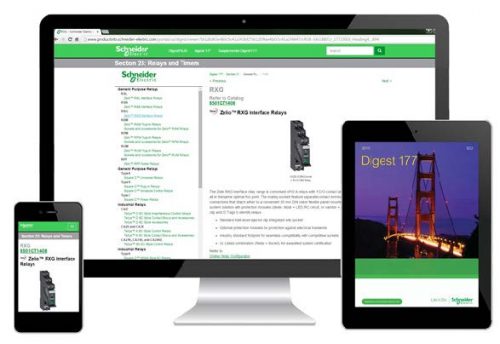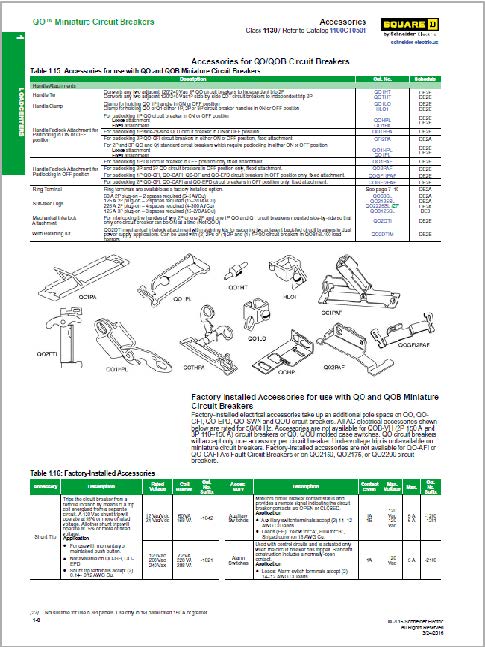Schneider Electric Case Study
Schneider Electric Digitizes Product Catalog to Improve Customers’ Experience
For over 80 years, the Schneider Electric North America product catalog, the Digest, has been viewed as Best in Class by customers. The 1,000-page Digest was developed as a print-first document: in 2012, 175,000 copies of the Digest were printed and distributed at a significant cost to Schneider. High publication costs along with a labor-intensive effort to update information caused many delays in delivering up-to-date information to customers. While surveys indicated an 87% rating that the printed Digest was either excellent or very good, only 68% rated the online PDF at the same level. The online PDF version of the Digest was too slow to download and use, did not provide an effective search capability, and was not compatible with mobile devices.
The Challenge of a Digest
With dozens of authors and product owners contributing content for more than 22,000 parts and products in one publication, it’s easy to see why Schneider Electric’s Digest is one of their most complex product catalog publications. The challenge of creating and maintaining a publication that contains over 1,000 pages of tables, detailed illustrations, simple descriptions, and rich technical content is a daunting task. Adding the latest requirement to make that same print and PDF information available in responsive design/HTML5 seemed unachievable. Fortunately for Schneider Electric’s documentation team, Kevin Habel had already developed an environment that was perfectly equipped to handle the complexities of the Digest and enable it to feed multiple delivery formats from a single source.
In mid-2014, Mark Mitchell (Digest project manager) began work with Habel to leapfrog competitors and start delivering digital Digest content. But first Mitchell and Habel had to secure buy-in from Digest stakeholders. While there was widespread recognition that the existing publication process was difficult and expensive, moving such a high-profile effort to the MOTIF environment carried risk. If the project did not go well and the publication effort failed, there would be consequences.
The one-year migration of Framemaker content to structured DITA included mapping the data, DITA and the MOTIF environment training, development of a Print / PDF stylesheet, and the many updates required to bring the Digest up-to-date with product information.
“When we went mobile, all the lights came on. Everyone saw the benefits of using DITA/XML and content management to create and publish this key document.”
Mark Mitchell, Digest Product Manager

The Solution
“Everyone wanted a more reliable approach. Mark Mitchell and I agreed that DITA was a proven foundation we could build on. We were confident the right pieces were in place and the new Digest would be a hit with customers.”
Kevin Habel
Moving to DITA XML Authoring Promotes Efficiency
A few years earlier, Habel had achieved significant savings by migrating Schneider Electric’s technical documentation to the MOTIF environment. MOTIF’s foundation is based on the Darwin Information Typing Architecture (DITA), an open-source, extensible markup language (XML) that defines rules for encoding content so it is easy to reuse in multiple documents and output formats. MOTIF encompasses several PTC authoring and content management tools including Arbortext Editor, Arbortext IsoDraw, Creo Illustrate, and Windchill. In combination with specific workflow processes, MOTIF makes it easier for authors to structure, develop, manage, and publish content.



Teaming Up with Content Delivery Specialists Speeds Implementation
“The idea of digitizing the Digest seemed overwhelming at the start. It was great when we were able to have all our DITA content transformed and available online for customers in just five weeks.”
Mark Mitchell

Turning the Digest into a Living Document
Schneider Electric typically reprints the hardcopy version of the Digest every three years. The Digest was simply too large, complex, and expensive to consider more frequent updates. In its digital format, however, as-needed digital updates became practical, affordable, and timely.
With all Digest content available in responsive HTML5, Schneider has achieved the final step towards a full “end-to-end” mobile solution for delivering this popular catalog. Writers have improved their development and publishing processes and source content has been migrated from page-oriented file formats to an open source topic-based format. With pre-built publishing templates, content authors are able to quickly update individual topics while having less concern about formatting. Publishing Digest updates to PDF is significantly more automated than before and publishing to HTML5 is nearing a fully automated process.
The company now releases digital Digest updates once each quarter. The digital format is becoming increasingly popular with customers who use its built-in search features to filter searches and quickly locate needed products.The project was so successful, Schneider Electric presented the Digest team with a top global award during 2015. Other Schneider groups have asked Habel to assist them with bringing the same efficiencies to their publication efforts.
“We can now add content and fix errors in a timely manner. Responsive content on mobile has allowed us to leapfrog competitors.”
Kevin Habel